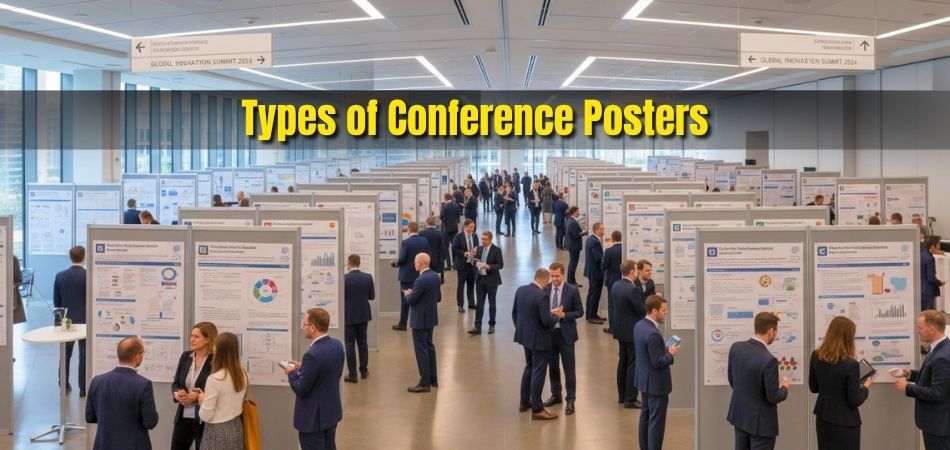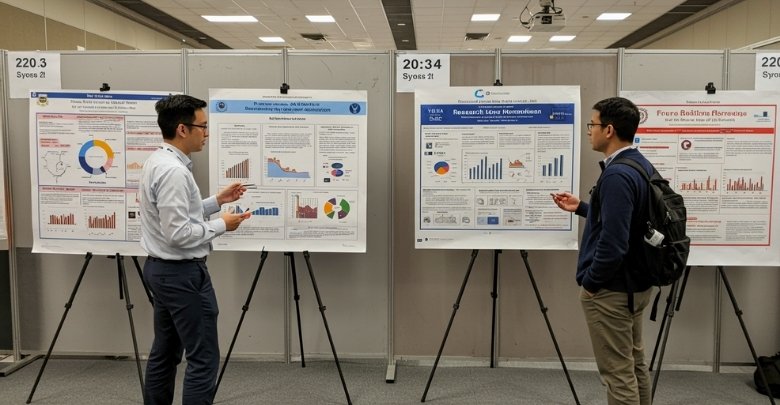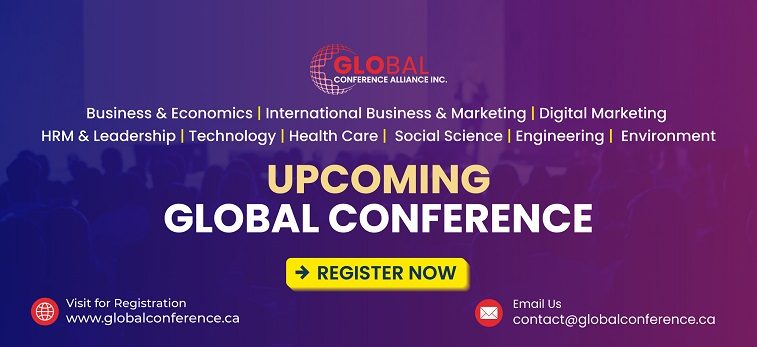Conference posters are one of the most eye-catching ways to share ideas at events. They turn complex topics into simple visuals that everyone can understand. People often use them to present studies, highlight projects, or promote events clearly and creatively. You might be wondering about the different types of conference posters that make each presentation unique and effective.
The main types of conference posters include informative, research, scientific, educational, and case study. Each serves a different purpose, from sharing data or teaching concepts to promoting events. Knowing the type helps define your message clearly for exhibitions, academic events, or public displays.
Would you like to know more about how each poster type works and when to use them? If yes, keep reading to explore this article and find every important detail explained in a simple, easy way.
Types of Conference Posters
Posters at conferences share ideas in visual and simple ways. Some explain studies, while others promote events or teach concepts. Each type has a different purpose and layout. Knowing these types helps people design posters that suit their goals. Keep reading to see each type explained clearly below.

Informative Poster
If you want to share key details about a topic in a simple way, an informative poster is perfect. It highlights background points, main ideas, and short summaries in a clear, easy-to-read layout. People can understand the message quickly, which is why these posters are often used at exhibitions, fairs, and awareness events.
Research Poster
This one shows the findings of a study or project. It includes a title, introduction, goals, methods, data, and results. Charts or graphs make the data easy to understand. It ends with a clear conclusion. Research posters are often seen at academic events, science fairs, and technical meetings.
Scientific Poster
A scientific poster explains a detailed experiment or study. It highlights the research question, hypothesis, materials, and results. You can find many inspiring scientific poster examples that show how to present data clearly. Graphs, tables, and figures help display findings well. These are common in science, medicine, and engineering events.
Educational Poster
In this type, a process or idea is explained or taught. It uses easy text, pictures, and diagrams to make learning fun and simple. It can be about health, safety, or training topics. Educational posters are popular in schools, workshops, and community events because they make learning more visual.
Case Study Poster
This kind highlights one real-life example or project. It explains the problem, the process used, and the final result. It’s a clear way to show how something was done and what was learned. These posters are used in business, medical, and engineering fields to show practical solutions and results.
Conceptual Or Theoretical Poster
Ideas are the basis for this poster type, rather than data. It introduces a model, concept, or theory and explains how it works. It may also show how the idea can be tested or used. These are common when sharing new approaches or future plans in research and innovation events.
Interactive or Digital Poster
This kind is shown on a screen or computer. It may have short videos, animations, or clickable links. The goal is to keep viewers engaged and informed. Digital posters are often used at tech events or modern conferences where people can explore the content in a fun, active way.
Promotional Poster
It is used to advertise a product, event, or service. Instead of text, it focuses on design and visuals. The goal is to grab attention and share a short, clear message. These posters are used to promote conferences, workshops, and company services in a bright and eye-catching style.
Why Are Conference Posters So Important?
Posters play a big part in sharing ideas at conferences. They help people present their work in a quick and visual way. Posters make complex topics easier to understand for everyone. Keep reading to learn why these posters are so valuable and how they help both presenters and viewers.
Help Share Knowledge Easily
Conference posters make it simple to share key facts and ideas. They use short text, pictures, and charts to explain things fast. This helps people understand, even if they are new to the topic. A well-made poster can turn complex research into clear, easy-to-grasp information for everyone.
Grab Attention Quickly
Posters are designed to catch the eye and draw interest. Bright colors, bold titles, and clear images make people stop and look. Once someone is curious, they read more to learn about the topic. A good design can turn a small idea into something everyone talks about at the event.
Encourage Face-to-face Talks
A big reason posters matter is that they start real conversations. Presenters stand by their posters to explain and answer questions. This direct contact helps make strong professional connections. Many great research ideas and projects begin with simple talks beside a poster board at a conference.
Showcase Research Clearly
Posters are a great way to show research results in a short time. Charts, tables, and graphs make data easy to see and understand. These visual aids help people follow the main points without needing long reports. This makes learning from posters both quick and enjoyable.
Promote Creative Presentation Skills
Creating posters helps presenters practice how to share ideas creatively. It’s not only about words but also about design and layout. Choosing colors, fonts, and pictures helps improve visual skills. These skills are useful in many careers that need clear and creative communication.
Build Professional Confidence
Standing next to a poster and explaining it builds confidence. It helps presenters talk about their ideas clearly and handle questions. Over time, this boosts their speaking and communication skills. Sharing work in a public space is a great way to grow both personally and professionally.
Support Learning and Teaching
Posters are also powerful learning tools. They help explain hard topics in simple ways through visuals. Teachers, trainers, and students often use them to share lessons. They make learning active and fun. Many workshops and academic events include posters to teach new ideas in creative ways.
Promote Events or Projects
Posters are not just for research; they can promote things as well. Many conferences use posters to announce events, services, or new programs. These posters use short text and strong visuals to attract attention. When used well, they can help raise awareness and draw people to join or participate.
How Do Research Posters Differ From Informational Posters?
Posters are powerful tools for sharing knowledge in a simple way. But not all posters serve the same purpose or follow the same style. Research posters and informational posters may look alike, but they work differently. Keep reading to understand their main differences in a clear and easy way.
Purpose and Goal
Research posters aim to share study results or findings with others. They are used to show research progress or new discoveries. Informational posters, on the other hand, share general knowledge about a topic. Their goal is to teach or spread awareness in a simple, visual format.
Content and Structure
The layout of research posters includes sections like title, methods, data, and conclusion. They are more detailed and include clear study results. Informational posters focus on key facts and short explanations. They avoid heavy data and instead highlight the main points in simple sentences and visuals.
Use of Data and Evidence
Research posters rely on data, charts, and tables to explain findings. Every point is supported by collected information or tested results. Informational posters do not need deep data or studies. They focus on general facts or tips that help people understand a subject in a quick and simple way.
Target Audience
The audience for research posters often includes experts, students, and professionals. They expect detailed results and scientific explanations. Informational posters are made for a wider audience. They are easy to read for anyone who wants to learn about a topic or event without too much detail.
Design and Presentation Style
Both types use visuals, but the focus is different. Research posters use graphs, charts, and tables to show results clearly. When creating effective research posters for conference, designers focus on layout and flow. Informational posters use pictures, icons, and colors to make ideas easy to follow. The goal in both is to keep the message clear and engaging.
Tone and Language
Research posters use formal and clear language to describe studies. They include terms that match the subject area. Informational posters use simple, friendly, and direct words. They avoid complex terms and focus on easy reading. This makes them ideal for public displays or awareness campaigns.
Common Settings
Research posters are often presented at academic, technical, or scientific conferences. They allow researchers to share new ideas and get feedback. Informational posters are found in schools, events, or workplaces. They help spread messages, share safety rules, or explain community programs to the public.
Can Conference Organizers Use Different Poster Styles at Their Events?
Yes, conference organizers can use different poster styles at their events. Each event has its own theme, audience, and purpose to consider. For example, a conference in USA might include research, educational, and promotional posters to keep participants interested and make information easy to understand.
Different poster types help present ideas in unique and creative ways. Informative posters share quick details, while research posters show study results. This mix helps participants learn faster, connect better, and stay engaged throughout the event with a variety of visual presentations.
Using multiple poster styles makes conferences more interactive and memorable. It gives speakers a chance to highlight their work in creative formats. This approach also helps attendees absorb knowledge easily, keeping the event meaningful, organized, and enjoyable for everyone involved.
Printed vs. Digital Posters: Which One Works Better?
Both printed and digital posters help share ideas and attract attention. Each type has its own benefits and challenges. Let’s look at how they compare in simple and clear points below.
| Aspect | Printed Posters | Digital Posters |
| Presentation Method | Displayed on walls, stands, or boards using paper materials. | Shown on screens, tablets, or large digital displays. |
| Cost | Printing and reprinting can be costly for big events. | Setup may cost more once, but it saves printing costs later. |
| Design Options | Limited to static visuals and printed colors. | Allows motion, videos, and animations for better engagement. |
| Sharing Method | Can be seen only in person at the venue. | Easy to share online through links or drives. |
| Space Use | Needs physical space for display and viewing. | Saves space by using digital screens or projectors. |
| Updates | Cannot be changed once printed or displayed. | Can be edited and updated anytime with ease. |
| Environmental Effect | Uses paper, ink, and other print materials. | Eco-friendly as it reduces paper and ink use. |
| Audience Appeal | Feels classic, simple, and easy to view offline. | Feels modern, dynamic, and attractive for tech-savvy audiences. |
How to Choose the Right Type of Poster for Your Conference?
Picking the right poster for a conference can make a big difference. Each poster type shares ideas in a special way. Choosing one depends on your topic, audience, and goal. Keep reading to learn how to pick the best type for your next event.
Recognize Your Main Purpose
Before making a poster, think about what you want it to do. Do you want to share research, teach something, or promote an event? Once you know your goal, it becomes easier to pick the right poster type. A clear purpose leads to a stronger and more focused poster.
Know Your Audience
Every conference has a different crowd. Some are experts, and others are general viewers. Knowing your audience helps you choose the best tone, visuals, and language. For example, a research group may prefer charts and data, while a public event may need short text and bright designs.
Decide on the Poster Format
There are many formats, like printed, digital, or interactive. Printed posters are simple and easy to view in person. Digital posters allow videos and animations that grab attention. Choosing the right format depends on your event setup and how you plan to engage with viewers.
Match Poster Type With Your Content
Each poster type fits certain topics better. Research posters suit detailed studies and data. Informative posters work well for general topics. Educational posters explain ideas or teach a concept. Matching your content to the poster type keeps your message clear and easy to understand.
Focus on Visual Design
Design is what makes people stop and look. Use clean layouts, readable text, and good color balance. Add visuals that match your topic and make it clear. A well-designed poster not only looks nice but also helps people remember the key points better.
Keep Information Simple and Clear
Avoid adding too much text or complex charts. Viewers should understand your message at a quick glance. Use short sentences, clear headings, and simple visuals. Posters are about showing, not telling too much. Keep only the most important points that deliver your main idea.
Review and Get Feedback
Before the event, ask others to review your poster. Feedback helps you spot mistakes and improve clarity. Check if the layout is easy to follow and if the message makes sense. A small change can make a big difference in how people see and understand your work.
Conference Posters: Are They Easy to Design?
Yes, conference posters are easy to design when you plan them with care and purpose. Creating one starts with understanding the topic clearly. Once you know your goal, you can decide what message you want to share. Simple layouts, short text, and clear visuals help people understand your poster quickly and easily.
Designing a good conference poster does not require special design skills. You only need to focus on clarity, balance, and presentation. Use readable fonts, clean backgrounds, and colors that match the topic. A well-organized layout with short points makes your poster both attractive and meaningful to viewers.
Many people enjoy designing conference posters because it lets them share their ideas visually. It gives them a creative way to explain research, projects, or events. Good posters grab attention and start conversations with others at the conference. With simple tools and careful thought, anyone can design a poster that stands out and connects well.
Common Mistakes to Avoid When Designing a Poster
Designing a poster looks simple, but small mistakes can ruin its impact. Many people focus on looks and forget clear communication. Good posters need a balance between design and content. Keep reading to learn the most common mistakes and how to avoid them for better results.
Too Much Text
A crowded poster makes people lose interest quickly. Using long paragraphs and detailed points makes it hard to read. Keep your message short and focused on key ideas only. Use simple words and short sentences so your poster is easy to follow and understand at a glance.
Poor Color Choices
Choosing colors without planning can make a poster look messy. Avoid mixing too many bright shades that clash with each other. Pick a few colors that match your theme and stay consistent. Soft contrast between background and text helps your message stand out clearly and looks neat.
Unreadable Fonts
Fancy or small fonts may look stylish, but reduce readability. Always use clear and simple fonts that are easy to read from a distance. Keep text large enough so viewers don’t struggle to see it. Consistent font size and style make the whole design look professional and balanced.
Lack of Visual Balance
When pictures, text, and charts are not placed evenly, posters look unorganized. Leave enough space between sections to make it easy on the eyes. Center your main content so it draws attention naturally. A neat, balanced design keeps viewers engaged and helps them focus on key details.
Ignoring the Target Audience
Every poster should match the people it’s meant for. A poster for experts will differ from one for the public. Adjust your tone, visuals, and text level based on who will see it. Understanding your audience helps you share your message more effectively and with better impact.
Overusing Graphics
Too many images can confuse the reader and clutter your layout. Use visuals only where they add meaning or support the message. Each picture or chart should serve a clear purpose. Keeping the design simple and direct makes your poster look tidy and professional while staying informative.
Missing Key Information
Sometimes posters forget to include important details like titles, dates, or contacts. These small parts make your message complete and useful. Always check your poster for missing details before printing or sharing. A complete, clear poster helps your audience understand the topic and know what to do next.
Frequently Asked Questions
Posters play a key role in sharing ideas during conferences. Many people often have questions about how posters are planned, used, and presented. Below are some common questions with simple and clear answers to help you understand more about conference posters.
What Makes a Poster Stand Out at a Conference?
A great poster stands out when it looks clean, balanced, and easy to read. It should have strong visuals, short text, and clear sections. Good color contrast and neat fonts make it inviting. A focused message and simple design help people notice and remember it.
How Do Posters Help During Presentations?
Posters act like visual support while you talk. They help guide your audience through the main points. You can point to charts or images to explain better. This makes your talk smoother and keeps the audience interested throughout your session.
What Size Should a Conference Poster Be?
Most posters are large enough to be read from a short distance. A common size is A0 or A1, depending on event rules. The key is to make text and images large and clear so people can easily see and read them comfortably.
Can Colors Affect How a Poster Is Seen?
Yes, colors have a strong effect on how people view a poster. Bright but balanced shades grab attention, while soft tones make reading easier. Using too many colors can be distracting, so it’s best to stick with two or three that fit your theme.
What Are Some Common Materials for Printed Posters?
Printed posters are usually made from matte or glossy paper. Some are printed on vinyl for better durability. Matte paper reduces glare under strong light, while glossy finishes look brighter. The choice often depends on budget and the event setup.
Can You Use Photos in a Poster Design?
Yes, photos make posters more attractive and relatable. They help people connect with the message quickly. Make sure the photos are clear, high-quality, and relevant to your topic. Avoid crowding too many images on one page to keep the layout clean.
How Important Is Font Style in Poster Design?
Font style plays a big role in readability. Use simple fonts like Arial, Calibri, or Helvetica. Keep titles bold and large while keeping text easy to read from a few feet away. Avoid fancy fonts that may look stylish but are hard to read.
How Long Should It Take to Read a Poster?
A good poster should be readable in about three to five minutes. That means keeping only key information and visuals. People at conferences move fast, so your poster must explain the idea quickly and clearly without long text or unnecessary details.
Can a Poster Include QR Codes?
Yes, QR codes are a great addition to modern posters. They allow viewers to scan and access more details, videos, or reports. It saves space and keeps the design clean. Always make sure the QR code links work and lead to helpful content.
How Early Should You Start Designing a Poster?
It’s best to start at least two to three weeks before the event. Early planning gives you time to design, check, and make changes. You can also get feedback from others to improve clarity. Rushing often leads to mistakes and poor layouts.
Bottom Lines
Conference posters bring ideas to life in a visual and simple way. They turn complex information into something that’s easy to understand and remember. Each style offers a new way to connect with people and share knowledge effectively.
Knowing the different types of conference posters helps presenters choose the right format for their topic. Whether it’s research, education, or promotion, each poster serves a unique purpose. The right choice can make a big impact on how people receive and remember your message.
No matter the design or topic, a well-thought-out poster always stands out. It sparks curiosity, invites questions, and leaves a lasting impression. Every poster has the power to inform, inspire, and connect people in meaningful ways.








